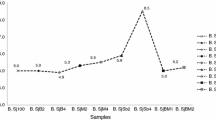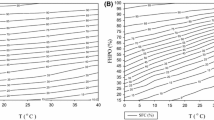Abstract
Oilseed crop with high oil content and promising ecological adaptability are potential sources for competitive biodiesel production. This study investigates the scope of utilizing biodiesel development through the methyl and ethyl ester from soybean and mustard oil as an alternative fuel. Methyl and ethyl esters of oils having different fatty acids compositions such as soybean (SOME and SOEE) and mustard oil (MUME and MUEE) were prepared by transesterification with methanol and ethanol in the presence of an alkali-KOH catalyst. The gas chromatographic (GC) analysis of oil samples revealed that primary fatty acid composition in soybean oil was linoleic acid (C18:2, 51.93%), followed by oleic acid (C18:1, 22.82%), palmitic acid (C16:0, 11.56%), linolenic acid (C18:3, 5.95%) and stearic acid (C18:0, 4.32%). Whereas, the main components in mustard oil were erucic acid (C22:1, 32.81%), oleic acid (C18:1, 24.98%), eicosenoic acid (C20:1, 10.44%), linolenic acid (C18:3, 8.61%) and palmitic acid (C16:0, 2.80%). The physicochemical properties (acid value, iodine value, calorific value, flash point, pour point etc.) of methyl and ethyl ester samples were estimated and found to be within the acceptable range of ASTM D6751 standards specifications. The prepared esters and oil samples were examined for cold flow properties by differential scanning calorimetry (DSC). Results revealed better cold flow properties for MUME (−2.55 °C) and MUEE (−3.10 °C) than SOME (3.21 °C) and SOEE (1.83 °C) due to more unsaturated fatty acid content in MU. Thermal and oxidative stability of samples was determined by thermogravimetric analysis (TG) and differential thermal analysis (DTA). The thermal and oxidative stability ranking of the samples was in the order of oil > methyl esters > ethyl esters.


Similar content being viewed by others
References
Ma F, Hanna MA. Biodiesel production: a review. Biores Technol. 1999;70(1):1–15.
Anbumani K, Singh AP. Performance of mustard and neem oil blends with diesel fuel in CI engine. Carbon. 2006;86(78):92.
Peterson CL. Vegetable oil as a diesel fuel: status and research priorities. Trans ASAE. 1986;29(5):1413–22.
Sarala M, Velu V, Anandharamakrishnan C, Singh R. Spray drying of Tinospora cordifolia leaf and stem extract and evaluation of antioxidant activity. J Food Sci Technol. 2012;49(1):119–22.
Das L, Bora DK, Pradhan S, Naik MK, Naik S. Long-term storage stability of biodiesel produced from Karanja oil. Fuel. 2009;88(11):2315–8.
Ayetor GK, Sunnu A, Parbey J. Effect of biodiesel production parameters on viscosity and yield of methyl esters: Jatropha curcas, Elaeis guineensis and Cocos nucifera. Alex Eng J. 2015;54(4):1285–90.
Atabani AE, Silitonga AS, Badruddin IA, Mahlia T, Masjuki H, Mekhilef S. A comprehensive review on biodiesel as an alternative energy resource and its characteristics. Renew Sustain Energy Rev. 2012;16(4):2070–93.
Dunn RO. Thermal analysis of alternative diesel fuels from vegetable oils. J Am Oil Chem Soc. 1999;76(1):109–15.
Dunn RO. Crystallization behavior of fatty acid methyl esters. J Am Oil Chem Soc. 2008;85(10):961–72.
Adhvaryu A, Erhan S, Perez J. Wax appearance temperatures of vegetable oils determined by differential scanning calorimetry: effect of triacylglycerol structure and its modification. Thermochim Acta. 2002;395(1):191–200.
Nik WW, Ani F, Masjuki H. Thermal stability evaluation of palm oil as energy transport media. Energy Convers Manag. 2005;46(13):2198–215.
Zuleta EC, Rios LA, Benjumea PN. Oxidative stability and cold flow behavior of palm, sacha-inchi, jatropha and castor oil biodiesel blends. Fuel Process Technol. 2012;102:96–101.
Ajithkumar G, Jayadas N, Bhasi M. Analysis of the pour point of coconut oil as a lubricant base stock using differential scanning calorimetry. Lubr Sci. 2009;21(1):13–26.
Coutinho JA, Daridon J-L. The limitations of the cloud point measurement techniques and the influence of the oil composition on its detection. Pet Sci Technol. 2005;23(9–10):1113–28.
Garcia-Perez M, Adams TT, Goodrum JW, Das K, Geller DP. DSC studies to evaluate the impact of bio-oil on cold flow properties and oxidation stability of bio-diesel. Biores Technol. 2010;101(15):6219–24.
Ramalho E, Carvalho Filho J, Albuquerque A, de Oliveira S, Cavalcanti E, Stragevitch L, et al. Low temperature behavior of poultry fat biodiesel: diesel blends. Fuel. 2012;93:601–5.
Berchmans HJ, Hirata S. Biodiesel production from crude Jatropha curcas L. seed oil with a high content of free fatty acids. Biores Technol. 2008;99(6):1716–21.
Predojević ZJ. The production of biodiesel from waste frying oils: a comparison of different purification steps. Fuel. 2008;87(17):3522–8.
Felizardo P, Correia MJN, Raposo I, Mendes JF, Berkemeier R, Bordado JM. Production of biodiesel from waste frying oils. Waste Manag. 2006;26(5):487–94.
Demirbas A. Relationships derived from physical properties of vegetable oil and biodiesel fuels. Fuel. 2008;87(8):1743–8.
Allen CA, Watts K, Ackman R, Pegg M. Predicting the viscosity of biodiesel fuels from their fatty acid ester composition. Fuel. 1999;78(11):1319–26.
Mazumdar P, Borugadda VB, Goud VV, Sahoo L. Physico-chemical characteristics of Jatropha curcas L. of North East India for exploration of biodiesel. Biomass Bioenerg. 2012;46:546–54.
Fan X, Burton R, Austic G. Preparation and characterization of biodiesel produced from recycled canola oil. Open Fuels Energy Sci J. 2009;2(1):113–8.
Ramadhas AS, Jayaraj S, Muraleedharan C. Biodiesel production from high FFA rubber seed oil. Fuel. 2005;84(4):335–40.
Refaat A. Correlation between the chemical structure of biodiesel and its physical properties. Int J Environ Sci Technol. 2009;6(4):677–94.
Knothe G, Bagby MO, Ryan TW III. Precombustion of fatty acids and esters of biodiesel. A possible explanation for differing cetane numbers. J Am Oil Chem Soc. 1998;75(8):1007–13.
McCormick RL, Graboski MS, Alleman TL, Herring AM, Tyson KS. Impact of biodiesel source material and chemical structure on emissions of criteria pollutants from a heavy-duty engine. Environ Sci Technol. 2001;35(9):1742–7.
Gunstone FD. Rapeseed and canola oil: production, processing, properties and uses. Boca Raton: CRC Press; 2004.
Gunstone FD. Fatty acid and lipid chemistry. London: Blackie Academic & Professional; 1996.
Kaya C, Hamamci C, Baysal A, Akba O, Erdogan S, Saydut A. Methyl ester of peanut (Arachis hypogea L.) seed oil as a potential feedstock for biodiesel production. Renew Energy. 2009;34(5):1257–60.
Conceiçao MM, Candeia RA, Dantas HJ, Soledade LE, Fernandes VJ, Souza AG. Rheological behavior of castor oil biodiesel. Energy Fuels. 2005;19(5):2185–8.
Goodrum JW, Eiteman MA. Physical properties of low molecular weight triglycerides for the development of bio-diesel fuel models. Biores Technol. 1996;56(1):55–60.
Abramovic H, Klofutar C. The temperature dependence of dynamic viscosity for some vegetable oils. Acta Chim Slov. 1998;45(1):69–77.
Kanitkar A, Balasubramanian S, Lima M, Boldor D. A critical comparison of methyl and ethyl esters production from soybean and rice bran oil in the presence of microwaves. Biores Technol. 2011;102(17):7896–902.
Canakci M, Sanli H. Biodiesel production from various feedstocks and their effects on the fuel properties. J Ind Microbiol Biotechnol. 2008;35(5):431–41.
Pérez Á, Casas A, Fernández CM, Ramos MJ, Rodríguez L. Winterization of peanut biodiesel to improve the cold flow properties. Biores Technol. 2010;101(19):7375–81.
Knothe G. Dependence of biodiesel fuel properties on the structure of fatty acid alkyl esters. Fuel Process Technol. 2005;86(10):1059–70.
Dunn RO. Cold weather properties and performance of biodiesel. In: Knothe G, Van Gerpen J, Krahl J, editors. The biodiesel handbook. Champaign, IL: AOCS Press; 2005. p. 83–121.
Farias AFF, da Conceição MM, Cavalcanti EHS, Melo MAR, dos Santos IMG, de Souza AG. Analysis of soybean biodiesel additive with different formulations of oils and fats. J Therm Anal Calorim. 2016;123(3):2121–7.
Forero-Doria O, Gallego J, Valdes O, Pinzon-Topal C, Santos LS, Guzmán L. Relationship between oxidative stability and antioxidant activity of oil extracted from the peel of Mauritia flexuosa fruits. J Therm Anal Calorim. 2016;123(3):2173–8.
Worzakowska M. TG/DSC/FTIR/QMS studies on the oxidative decomposition of terpene acrylate homopolymers. J Therm Anal Calorim. 2017;127(2):2025–35.
Horváth F, Gombár T, Varga J, Menyhárd A. Crystallization, melting, supermolecular structure and properties of isotactic polypropylene nucleated with dicyclohexyl-terephthalamide. J Therm Anal Calorim. 2017;128(2):925–35.
Snyder J, Frankel E, Warner K. Headspace volatile analysis to evaluate oxidative and thermal stability of soybean oil. Effect of hydrogenation and additives. J Am Oil Chem Soc. 1986;63(8):1055–8.
Sricharoenchaikul V, Atong D. Thermal decomposition study on Jatropha curcas L. waste using TGA and fixed bed reactor. J Anal Appl Pyrol. 2009;85(1):155–62.
Park J-Y, Kim D-K, Lee J-P, Park S-C, Kim Y-J, Lee J-S. Blending effects of biodiesels on oxidation stability and low temperature flow properties. Biores Technol. 2008;99(5):1196–203.
Jain S, Sharma M. Review of different test methods for the evaluation of stability of biodiesel. Renew Sustain Energy Rev. 2010;14(7):1937–47.
Jain S, Sharma M. Thermal stability of biodiesel and its blends: a review. Renew Sustain Energy Rev. 2011;15(1):438–48.
Imahara H, Minami E, Hari S, Saka S, editors. Thermal stability of biodiesel fuel as prepared by supercritical methanol process. In 2nd Joint international conference on sustainable energy and environment (SEE 2006), Bangkok, Thailand. 2006.
Santos N, Santos J, Sinfrônio F, Bicudo T, Santos I, Antoniosi Filho N, et al. Thermo-oxidative stability and cold flow properties of babassu biodiesel by PDSC and TMDSC techniques. J Therm Anal Calorim. 2009;97(2):611–4.
Ikwuagwu O, Ononogbu I, Njoku O. Production of biodiesel using rubber [Hevea brasiliensis (Kunth. Muell.)] seed oil. Ind Crops Prod. 2000;12(1):57–62.
Conceição MM, Candeia RA, Silva FC, Bezerra AF, Fernandes VJ, Souza AG. Thermoanalytical characterization of castor oil biodiesel. Renew Sustain Energy Rev. 2007;11(5):964–75.
Jayadas N, Nair KP. Coconut oil as base oil for industrial lubricants—evaluation and modification of thermal, oxidative and low temperature properties. Tribol Int. 2006;39(9):873–8.
Knothe G. Analyzing biodiesel: standards and other methods. J Am Oil Chem Soc. 2006;83(10):823–33.
Knothe G. Some aspects of biodiesel oxidative stability. Fuel Process Technol. 2007;88(7):669–77.
Melo MAMF, de Melo MAR, Pontes ASGC, Farias AFF, Dantas MB, Calixto CD, et al. Non-conventional oils for biodiesel production: a study of thermal and oxidative stability. J Therm Anal Calorim. 2014;117(2):845–9.
Romeu-Nadal M, Chavez-Servin J, Castellote A, Rivero M, Lopez-Sabater M. Oxidation stability of the lipid fraction in milk powder formulas. Food Chem. 2007;100(2):756–63.
Acknowledgements
We sincerely acknowledge the Centre of Excellence for Sustainable polymers (CoE-SusPol) at IIT Guwahati, for providing the research facilities. We also thank to the Central Instruments Facility (CIF), IIT Guwahati for providing characterization facilities.
Author information
Authors and Affiliations
Corresponding author
Electronic supplementary material
Below is the link to the electronic supplementary material.
Rights and permissions
About this article
Cite this article
Paul, A.K., Achar, S.K., Dasari, S.R. et al. Analysis of thermal, oxidative and cold flow properties of methyl and ethyl esters prepared from soybean and mustard oils. J Therm Anal Calorim 130, 1501–1511 (2017). https://doi.org/10.1007/s10973-017-6424-z
Received:
Accepted:
Published:
Issue Date:
DOI: https://doi.org/10.1007/s10973-017-6424-z




